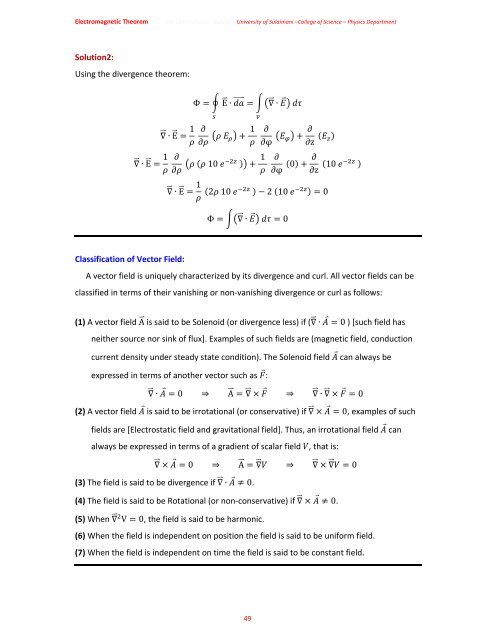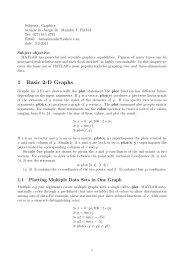Chapter One: Vector Analysis The use of vectors and vector analysis ...
Chapter One: Vector Analysis The use of vectors and vector analysis ...
Chapter One: Vector Analysis The use of vectors and vector analysis ...
Create successful ePaper yourself
Turn your PDF publications into a flip-book with our unique Google optimized e-Paper software.
Electromagnetic <strong>The</strong>orem<br />
(Dr. Omed Ghareb Abdullah) University <strong>of</strong> Sulaimani –College <strong>of</strong> Science – Physics Department<br />
Solution2:<br />
Using the divergence theorem:<br />
∙E 1 <br />
∙E 1 <br />
ΦE ∙ <br />
<br />
∂<br />
∂ 1 <br />
∂<br />
∂ 10 1 <br />
∙ <br />
<br />
∂<br />
∂φ ∂ ∂z <br />
∂<br />
∂φ 0 ∂ ∂z 10 <br />
∙E 1 2 10 2 10 0<br />
Φ ∙ 0<br />
Classification <strong>of</strong> <strong>Vector</strong> Field:<br />
A <strong>vector</strong> field is uniquely characterized by its divergence <strong>and</strong> curl. All <strong>vector</strong> fields can be<br />
classified in terms <strong>of</strong> their vanishing or non‐vanishing divergence or curl as follows:<br />
(1) A <strong>vector</strong> field A is said to be Solenoid (or divergence less) if ( ∙ 0 ) [such field has<br />
neither source nor sink <strong>of</strong> flux]. Examples <strong>of</strong> such fields are (magnetic field, conduction<br />
current density under steady state condition). <strong>The</strong> Solenoid field can always be<br />
expressed in terms <strong>of</strong> another <strong>vector</strong> such as :<br />
∙ 0 ⇒ A ⇒ ∙ 0<br />
(2) A <strong>vector</strong> field is said to be irrotational (or conservative) if 0, examples <strong>of</strong> such<br />
fields are [Electrostatic field <strong>and</strong> gravitational field]. Thus, an irrotational field can<br />
always be expressed in terms <strong>of</strong> a gradient <strong>of</strong> scalar field , that is:<br />
0 ⇒ A ⇒ 0<br />
(3) <strong>The</strong> field is said to be divergence if ∙ 0.<br />
(4) <strong>The</strong> field is said to be Rotational (or non‐conservative) if 0.<br />
(5) When V0, the field is said to be harmonic.<br />
(6) When the field is independent on position the field is said to be uniform field.<br />
(7) When the field is independent on time the field is said to be constant field.<br />
49
















